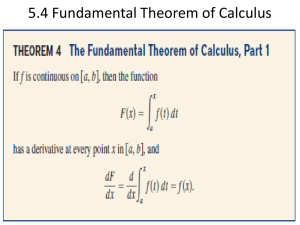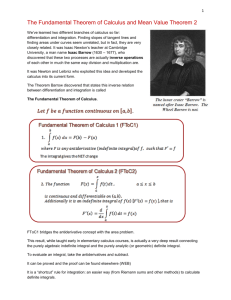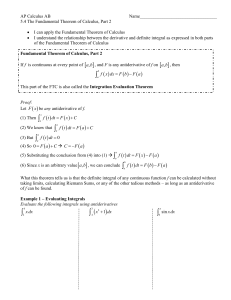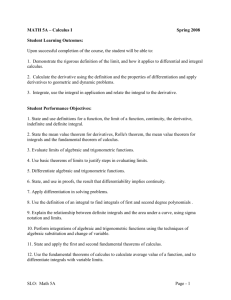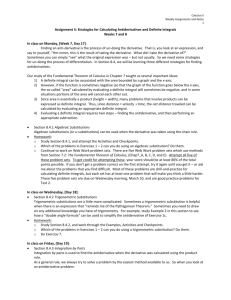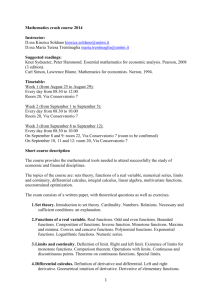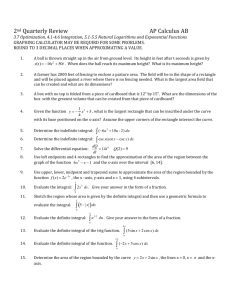5-4 Fundamental Theorem of Calculus Part 1
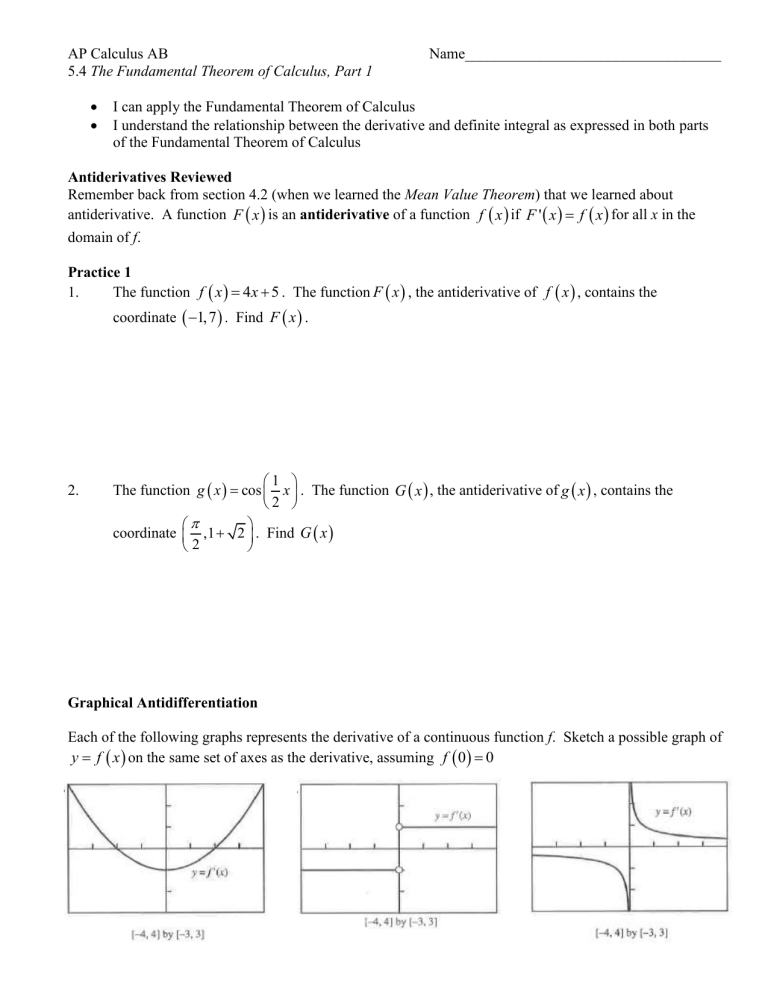
AP Calculus AB Name__________________________________
5.4 The Fundamental Theorem of Calculus, Part 1
I can apply the Fundamental Theorem of Calculus
I understand the relationship between the derivative and definite integral as expressed in both parts of the Fundamental Theorem of Calculus
Antiderivatives Reviewed
Remember back from section 4.2 (when we learned the Mean Value Theorem ) that we learned about antiderivative. A function
is an antiderivative of a function
if '
for all x in the domain of f .
Practice 1
1. The function coordinate
4 x
5 . The function
1, 7
. Find
.
2. The function
coordinate
2
,1
2 cos
1
2 x
. Find
. The function
, the antiderivative of
, the antiderivative of
, contains the
, contains the
Graphical Antidifferentiation
Each of the following graphs represents the derivative of a continuous function f . Sketch a possible graph of y
on the same set of axes as the derivative, assuming f
0
8.
4.
3.
Exploration 1 – Finding the Derivative of an Integral
1. Using the graph of f at the right, choose any x greater than a in the interval
and mark it on the x -axis.
2. Using only vertical line segments , shade the region between the graph of f and the x -axis from a to x .
Compare your picture with others produced by your group. Notice how your integral (a real number) depends on which x you chose in the interval
. The integral is therefore a function
of x on
. Since it is a function, let’s give it a unique name – call it
F . So
a x
.
Your shaded region representing F also represents a definite integral . Explain why this integral can be written as
a x and why we do NOT write it as
a x
Draw one more vertical line shading segment to the right of the last one you drew in step (2). Since
F is the function that represents the definite integral of f ,
F represents the area from x to the last line segment that you drew in step (4). Shade this area.
5. In the above shaded segment,
x represents the horizontal change from the x you chose in step (2) to the place on the x -axis where you started your vertical line in step (4). Mark
x on the graph.
6. Recall that along with
F algebraically as F
representing the area of the shaded region, it can be represented
. Then by the definition of a derivative, F '
lim x 0
F
x
7. What is the height of any individual vertical segment? What is an expression for the area of your shaded region?
Use the expression for area from step (8) to simplify the following:
F '
lim x 0
F
x
The power of what we discovered in step 9 above cannot be overstated (a more rigorous, algebraic proof can be found on pages 294-295 of our textbook if you are interested). This astonishing connection between differentiation and integration, in the words of the authors of our textbook, “fueled the scientific revolution for the next 200 years, and is still regarded as the most important computational discovery in the history of mathematics.” Due to this importance, the discover is called the Fundamental Theorem of Calculus
The Fundamental Theorem of Calculus, Part 1
If f is continuous on
, then the function
a x has a derivative at every point x in
, and dF
d dx dx
a x
Part 1 of the Fundamental Theorem of Calculus says that the definite integral of a continuous function is a differentiable function of its upper limit of integration.
Example 1
Find d dx
x cos t dt
Example 2
Find dy dx if y
1 x
2 cos t dt
Find d dx
0 x
1
1 u
2 du
Practice 2
1. Find dy dx if y
x sin
2 t dt 2. Find dy dx if y
0 x
3 t
cos t
2
dt
Find dy dx if
3. Find dy dx if y
0 x
2 t
2 e dt 4. Find dy dx if y
x
Example 3
We will need to use your rules of integration to rewrite these before using the FTC, Part 1 y
x
8 t
2
6 t 4 dt Find dy dx if y
2 x
2 x 2
1
e t dt
2 t
2 t dt
Example 4
Find a function y
with derivative dy dx
tan x that satisfies the condition f
5
Practice 3
5. Construct a function that has a derivative of dy dx
Homework for FTC, part 1:
sin
3 x , and y
0 when x
5 pg. 302 #’s 3, 4, 8, 10, 15, 17, 19, 20, 22, 25, 26


